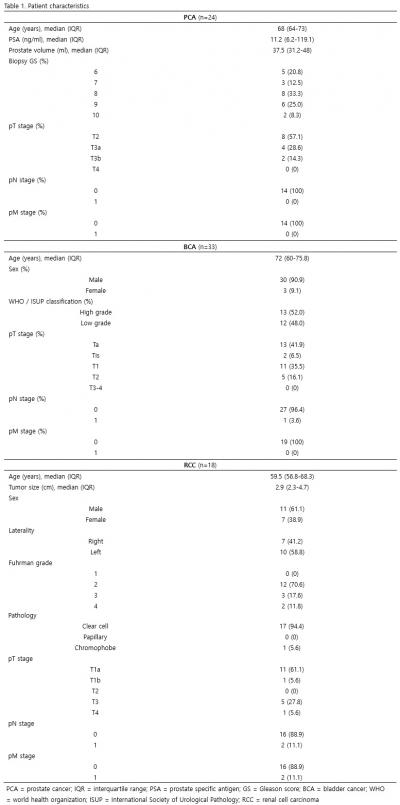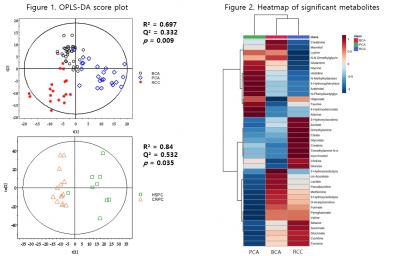|
Basic Research - Cancer(구연)
|
(E-010)
|
|
|
전립선암, 방광암, 신장암의 대사체 비교연구: 소변 검체에서 비뇨기계암 표지자 탐색 |
| 부산대학교병원 의과대학 비뇨의학교실¹ |
| 김경환¹, 박지훈¹, 강병진¹, 박시균¹, 이권경¹, 구자윤¹, 하홍구¹ |
Objectives
Studies to develop new biomarkers for urological cancers have been emerging recently. In this study, we aimed to elucidate and compare the metabolomic signatures between urological cancers using urine samples.
Materials and Methods
From Apr, 2017 to Sep, 2018, 75 urine samples were collected from 24 prostate cancer (PCA), 33 bladder cancer (BCA) and 18 renal cell carcinoma (RCC) patients. To identify the metabolites in urine sample, we performed nuclear magnetic resonance spectroscopy and quantified the peak intensity of the spectrum. Orthogonal partial least squares discriminant analysis (OPLS-DA) was conducted to yield the score plot. To compare the expression pattern of metabolites in three diseases, heatmap clustering analysis was used.
Results
Median age of PCA, BCA and RCC patients were 68, 72 and 59.5 years, respectively. In PCA, hormone sensitive cancer (HSPC) and castration resistant cancer (CRPC) patients were 8 and 16, respectively. In OPLS-DA score plot, the urine metabolites from PCA, BCA and RCC patients could be discriminated into 3 separate areas (p = 0.009). Urine metabolomic signatures were different between HSPC and CRPC (p = 0.035). Three distinct metabolomic clusters were identified on the heatmap. Significant metabolomic signatures encompassed glutamine, histidine, N-Methylhydantoin, arabinitol, N-phenylacetylglycine, taurine, 4-hydroxybenzoate for PCA, creatinine, mannitol for BCA and trimethylamine, betaine for RCC.
Conclusion
Urine metabolite signatures could be potential biomarkers for urological cancers.
|
  |
|
keywords : Metabolite, Urine, Urological cancer |
|

